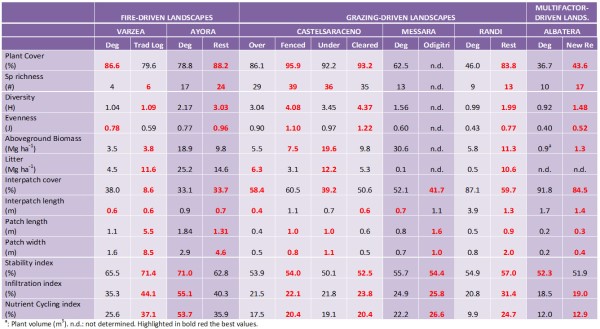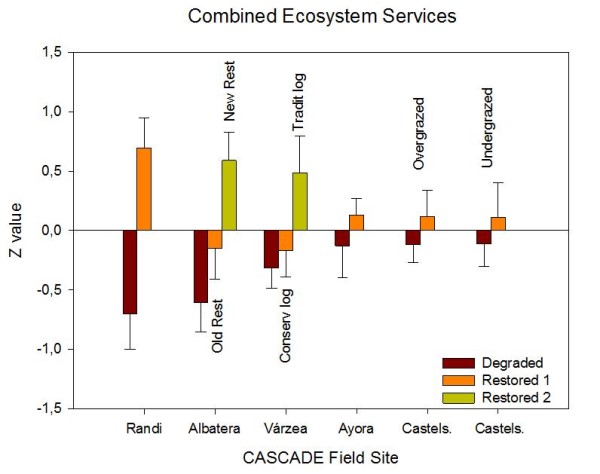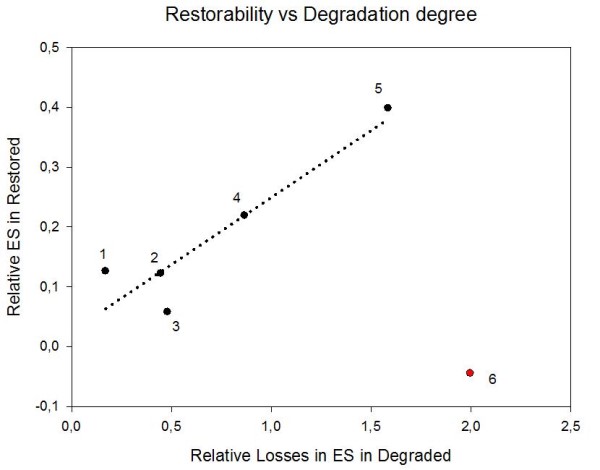| Authors: | Alejandro Valdecantos (CEAM),V. Ramón Vallejo (UB), Susana Bautista (UA), Matthijs Boeschoten (UU), Michalakis Christoforou (CUT), Ioannis N. Daliakopoulos (TUC), Oscar González-Pelayo (UAVR), Lorena Guixot (UA), J. Jacob Keizer (UAVR), Ioanna Panagea (TUC), Gianni Quaranta (UNIBAS), Rosana Salvia (UNIBAS), Víctor Santana (UAVR), Dimitris Tsaltas (CUT), Ioannis K. Tsanis (TUC) |
| Editor: | Jane Brandt |
| Source document: | Valdecantos, A. et al. (2016) Report on the restoration potential for preventing and reversing regime shifts. CASCADE Project Deliverable 5.2 104 pp |
The large heterogeneity of target ecosystems, properties, constraints and conditions of the six field sites resulted in a very wide range of values of the variables evaluated (Table 1). For instance, plant cover percentage ran from less than 40% in the degraded state of Albatera to above 95% in the fenced sites of Castelsaraceno. Similar disparities of data are found in diversity, productivity, patch size and distribution, and functionality indexes.

Fire-driven landscapes
We cannot do a generalization of either the impacts or the restoration potential of the two sites of the projects subjected to fire. Although Várzea and Ayora shared the reference ecosystem (pine forest), the restoration approaches and timing of application after fire are not comparable.
Várzea
In Várzea, traditional (salvage) logging resulted in better results than conservation logging in the short term, but extremely far from the reference forest. Natural pine forests show marked differences even with successfully restored forests. For instance, it has been shown that diversity and natural recruitment is significantly lower in restored pine forests than in undisturbed ones, especially under medium to low values of annual rainfall (Ruiz-Benito et al., 2012). These restored habitats also need additional restoration management such as thinning high density stands and increasing diversity through planting. In our case, the assessment of ecosystem properties and services has been carried out two years after the logging treatments were applied. This time frame is very short to detect any significant improvement. Both logging treatments showed reductions in biomass and plant cover in relation to the degraded areas (four times burned) probably related to the use of heavy machinery during the logging procedures. However, the stability, infiltration and nutrient indexes were improved in both restored sites in relation to the degraded.
Traditional logging in Várzea is a common practice in burned forests that, in Mediterranean ecosystems, has been justified to reduce further reforestation costs. However, Leverkus et al. (2012) observed that from an economic point of view a treatment similar to the conservation logging carried out in Várzea may release higher reforestation success than traditional logging with lower costs. Leverkus et al. (2014) reported lower plant species number, diversity and cover at the short-term (two years after treatment establishment) in post-fire salvage logged areas than in unmanaged burned sites or areas where wood debris were left on the ground in the SE of the Iberian Peninsula). Both logging treatments produce a homogenization of the landscape, higher in the traditional logging sites, while degraded areas without any post-fire intervention present higher heterogeneity in microclimatic conditions caused by burned plants that affect heterogeneity of resource distribution (Castro et al., 2011). In addition, salvage logging might decrease the vigor and growth of regenerating pine seedlings due to an increase of water stress, and a reduction of nutrient availability and microclimatic heterogeneity associated to standing dead wood (Moya et al., 2015), as well as increase the susceptibility of alien species to spread within the burned and salvage logged area (Moreira et al., 2013). The naturally regenerated pine seedlings in areas subjected to salvage logging usually show at the medium term lower ecophysiological performance, growth and cone production than those where more conservative logging practices were conducted (Marañón-Jiménez et al., 2013). The extraction of burned wood soon after fire may result in longer-term reductions of C sequestration than if wood had remained to decomposed in situ (Johnson et al., 2005). However, the net effect of salvage logging depends on the serotinity level of the stand (de las Heras et al. 2012). In general, post-fire emergency rehabilitation actions should be applied only to burned pine forests showing high erosion and runoff risk, with slow natural plant recovery rate Vallejo et al. (2012). These observations together with the data we recorded suggest that management activities soon after fire in Várzea may release negative net effects. On the other hand, the creation of piles of at least 50 cm height with the remains of the wood (branches and non-profitable logs), as in the conservation logging carried out in Várzea, enhances the abundance of seed dispersal bird species, especially in winter, and also richness breeding bird species, rodents, and mammals (Rost et al., 2010). Bautista et al. (2004) made some technical recommendations about the management of burned wood after fire. They included the avoidance of salvage logging in vulnerable soils until a protective vegetation cover develops, to keep some individuals as perches for birds nesting and seed dispersal, to conduct logging in patches promoting spatial heterogeneity, and to leave branches, trunks or chipped material on the ground to protect against erosion.
The unexpected better results of the traditional than the conservation logging in many ecosystem properties and services are due to the increase in patch size and cover in the former. This may lead to misunderstanding as patches in the two logging sites are not completely vegetated while interpatches are not exclusively bare soil but brush chip remains. More time is needed to assess whether the traditional and conservation logging treatments affect differently to the recovery of ecosystem properties in Várzea.
At the short term after the fire, passive restoration, e.g. by assisting natural germination or resprouting, is rather preferred than active restoration, e.g. by planting seedlings, due to the high costs and unpredictable results of the latter (Vallejo et al. 2012).
Ayora
In Ayora, restoration was conducted 23 years after the fire, when a mature shrubland was established and with the main objective of reducing fire hazard and improve vegetation resilience. The assessment was done eleven years after the application of selective clearing and plantation of resprouter seedlings. In this case, restoration at the medium term had positive impacts on most ecosystem properties and services, especially on biodiversity. Both the direct introduction of species that had locally disappeared and the increase of landscape heterogeneity by selective clearing might have promoted the significant improvement of biodiversity indexes in the restored plots. It has been observed that a thick and continuous understory layer reduces plant diversity (Royo and Carson, 2006). All other ecosystem services also improved except C sequestration as the restoration treatments included the removal of seeder fire-prone vegetation and hence the aboveground biomass. However, this fact fulfilled one of the objectives pursued by restoration as it is the reduction of the fire risk. The degraded shrubland presented two times higher amount of standing dead biomass than the restored plots. Reduction of fire hazard has been recognized as a regulating ecosystem service (Bagdon et al., 2016). The approach done to Fire Risk Reduction revealed a significant increase of this service in the Restored areas as compared to the Degraded and even to the Reference state of the ecosystem. The fuel model of the degraded community changed to less flammable types in the restored areas, probably from model 4 to 5. This is especially interesting as the reduction of fire hazard, together with increasing the resilience of the plant community, was the main objective of the restoration carried out. We have confirmed that fire risk was still reduced ten years after the application of the vegetation management treatments. In Ayora, shrublands are quite effective in protecting the soil, show high ecosystem attributes and, when resprouters are abundant, show high resilience (Vallejo et al., 2006). However and due to different reasons mainly related to stakeholders perception, restoring the forest that has been lost might be desirable.
Grazing-driven landscapes
Castelsaraceno and Randi Forest
In relation to grazing, Castelsaraceno (overgrazed) and Randi included similar restoration approaches based on grazing exclusion. In the two sites, general improvement of ecosystem properties and services were observed, especially related to enhancing biodiversity. In fact, grazing exclusion 20 years ago in Randi showed the greatest improvement in all the evaluated variables of all the field sites and ecosystem states (Table 1, Figure 1). Fenced in Castelsaraceno also improved all variables except interpatch length and litter accumulation. Changes in land use, like grazing exclusion as restoration measure, produce a trade-off between provisioning and regulating ecosystem services (Foley et al., 2005). Rong et al. (2014) reported an increase in vegetation cover, height and biomass both of the grass and shrub layers as well as in soil surface properties eight years after grazing was excluded from an arid continental region in China. However, these authors did not find significant differences in any diversity index between the degraded and the restored sites. But the effects of grazing exclusion in improving ecosystem properties are not immediate and straightforward. Li et al. (2012) observed the maximum effect of this practice on plant cover, diversity, biomass, and soil physical and chemical properties in areas with 13 and 26 years of enclosure. Passive restoration actions, such as fencing overgrazed areas or clearing shrub encroached sites, probably do not pursue a well-defined target ecosystem but alternative meta-stable states (Cortina et al., 2006).
On the other hand, and in areas where shrub encroachment is relevant like in Castelsaraceno undergrazed areas, the removal of woody vegetation by clearing may release both positive and negative effects on C sequestration in the soil depending on the precipitation regime of the site. Thus, Alberti et al. (2011) proposed that below 900 mm yr-1 of rainfall, soil C increases with clearing woody vegetation while above this threshold (corresponding to Castelsaraceno field site) the net effect of clearing on soil C sequestration is negative. Although we did not evaluate soil C, cleared areas in Castelsaraceno showed higher root biomass but less litter accumulation than undergrazed areas.
Significant changes in the composition of plant communities have been found according to the grazing pressure (overgrazed-reference-fenced and also undergrazed-reference-cleared in Castelsaraceno). The reduction of the relative abundance of unpalatable species in degraded areas or its replacement by other more palatable at the medium term after grazing exclusion has been previously reported in other Mediterranean drylands (Jeddi and Chaieb, 2010) as well as the modification of the relative proportion of different life-forms (Medina-Roldán et al., 2012). These changes in plant community composition are less pronounced in the most arid areas and increase both with precipitation and net primary productivity (Milchunas and Lauenroth, 1993). But not only composition is sensitive to grazing exclusion. Several studies reported an increase in diversity indexes such as those we have evaluated in the project (species richness, Shannon-Wiener’s and evenness indexes) after ca 10 years of excluding grazing (Jeddi and Chaieb, 2010; Wang et al., 2016). However, it has also been observed that species composition does not significantly change at moderate levels of grazing at the time that both regulating and provisioning ecosystem services are optimized (Oñatibia et al., 2015). These authors and others (e.g. Medina-Roldán et al. 2012) observed a reduction of C and N stocks in heavily grazed arid rangelands as compared to moderate grazed areas, and recommend a reduction of grazing pressure for increasing C sequestration rather that complete grazing exclusion. Probably, the definition of optimum intermediate stocking rates instead of complete grazing exclusion is a main objective for the management of these areas where grazing represents an important ecosystem service (Papanastasis et al., 2015).
Messara
The case of Messara is rather different than the other sites affected by grazing. The restoration did not aim to recover the pre-disturbance or reference state of the ecosystem but a transformation of land use from grazing to carob tree orchards as a silvopastoral or agroforestry system. Carob trees are a landmark of Greek landscapes as it is one of the greatest producers of carob pods (5.600 ha and 22.000 tons of pods in 2013; data from FAO), most of the production is concentrated in Crete. The reference, semi-degraded and degraded states in Messara represent different situations along the degradation trajectory while the restored options built alternative system through replacement following Bradshaw’s classical structure-function model (Bradshaw 1984). Under this situation, the assessment based on the spatial arrangement of vegetation, the contribution of patches and interpatches to the landscape, and the evaluation of soil surface properties provides useful insights of ecosystem properties but does not represent a reliable approach of the restoration potential of ecosystem services of these degraded sites. The incorporation of plant cover and plant biomass will surely result in significant improvements of the ecosystem services included in this report. The possibility of getting external funds from the EU Common Agricultural Policy for this agroforestry transformation, as happened in Melidochori, is another aspect to be considered in the final balance of the impacts of this land management alternative. In addition, provisioning services such as fodder or gum products (Papanastasis 1989) can be provided by this transformation from overgrazed areas to carob tree orchards when physical features of the site, especially soil depth, are appropriate.
Multifactor-driven landscapes
Albatera
In the field site with the highest aridity index, Albatera, there was an important improvement of ecosystem services and properties due to the development of new restoration technologies, such as higher number of planted species, species selection based on geomorphological features, compost application or water harvesting structures (Chirino et al., 2009). However, despite both the new and the traditional restoration improved the state of the degraded ecosystem, its properties are still far from the values of the undisturbed reference sites. One of the reasons underlying the better performance of the planted seedlings in the new than in the old restoration approach is that it included the optimization of hydrological properties that have significant effect on restoration success (Urgeghe and Bautista, 2015). It is important to highlight that the new restoration action in Albatera was applied only ten years before the assessment, and even so it already yielded much better results than the traditional approach implemented several decades ago. We expect that the positive effects of this management option will increase over time as ecological processes act at slow rate in these extremely stressed sites (Pugnaire et al., 2006).
Conclusions
Our analytical approach to evaluate the potential to restore areas impacted by fire, grazing or multiple simultaneous stresses has provided useful insights on constraints and opportunities for restoration that may be considered when designing landscape management options. Our assessment is based on biophysical features in the different states of the ecosystem and special weight relies on Landscape Function Analysis. Other services that has not been quantified in this report such as the reduction of fire risk in Várzea or the provisioning services especially in Castelsaraceno could also be considered to better capture the net outcome of restoration actions.
Stakeholders perception about ecosystem services and properties should be incorporated in the decision making (Bullock et al. 2011).


The study sites represent different degradation drivers, different intensities and duration of pressures, and different climatic, water stress and soil vulnerablity to degradation of representative Mediterranean landscapes. However, the contrast between reference and degraded sites, and between patch and interpatch characteristics constitute an ecologically-sound common indicator of degradation severity. Restoration measures also yielded different outcomes, e.g. different degree of change in ecosystem properties and services. Different restoration treatments and evaluation times after application, and the diverse nature of restoration trechniques applied are factors that modulated restoration results. Despite this variation, when the degree of ecosystem change achieved by restoration (relative to degraded states) is analyzed as a function of the relative impact of degradation (relative to the reference state), we observed a global positive relationship between them (Figure 2), so that the more intense the loss of services the higher the effects of restoration on the recovery of those services. However, one of the sites, Albatera, does not follow this pattern. The stressful conditions in Albatera site (the highest aridity index) determine the slow recovery of ecosystem dynamics and properties even in case of successful restoration practices. Furthermore, despite the multiple degradation factors that drove the ecosystem to its degraded state ceased many decades ago, Albatera did not ever show any sign of self-recovery towards healthier conditions, which indicates that the pressures exerted in the past triggered the shift of the system to a particularly severe degraded alternative state that has proven to be rather stable.
Note: For full references to papers quoted in this article see
